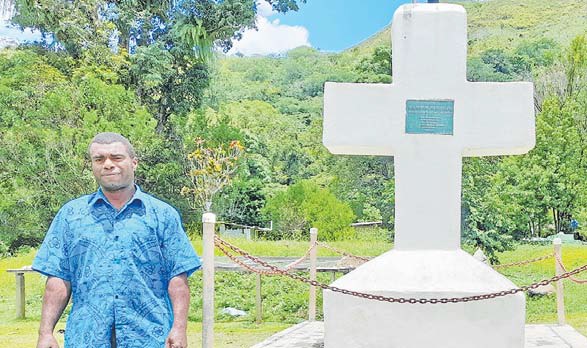If there was one resounding change that Christianity brought to Fiji, it brought peace.
Warring clans and fiefdoms who accepted the Word of God and the message of love, forgiveness and tolerance of Jesus Christ put down their clubs and spears. Instead of declaring war, they converted and changed their way of life.
However, the change was not instantaneous. It was a process and Jovili Lewamosa of Nakoro Village in Noikoro district in the Navosa highlands shared what had been passed down to him on his forefathers’ journey of change.
But before we delve into his tale, it is important to set the stage of where these events took place.
As you stand up in the highlands of Navosa overlooking the Sigatoka valley, the first thing that will capture your imagination is the jagged landscape of yawning gullies and steep mountain tops.
The terrain is unforgiving and one can only appreciate the efforts of the early Christian missionaries in spreading the word of God to such remote places.
That, and considering that the Navosa highlands contained some of the most notorious savage tribes in the Fiji Group, would have made lesser men fearful and reluctant to make the life-threatening journey to bring salvation to the people of the highlands.
When you talk to the people of Nakoro Village, the progenies of the warring tribes say they are forever thankful for the sacrifices made by the early missionaries because the fruit it has borne is peace and enlightenment.
The Nakoro people tell of the arrival of Christianity among their people and how it was communicated to their chief Ratu Vucukula Taninatukatuka – a warlord of the hill tribe as the arrival of a garment of light.
While sharing the story of the arrival of Christianity in Nakoro, Mr Lewamosa said that when the early missionaries arrived on Viti Levu in the 1830s, the chiefly island of Bau wielded power over Viti Levu had been quick to receive the new religion.
Ratu Cakobau received Christianity and befriended the white missionaries.
“After receiving Christianity, Ratu Cakobau then instructed his people that in order for peace and stability to exist, the warring tribes of the highlands needed to be converted to Christianity,” Mr Lewamosa said.
“Thus he encouraged that the missionaries venture out to the highlands to get the chiefs converted to the religion of peace.
“One of these chiefs was our own forefather, Ratu Taninatukatuka who was revered by the people of Noikoro as a great warrior.
“We were told that during his lifetime, his people feared ever crossing pathways with Ratu Taninatukatuka or even having a disagreement with him because it spelled doom for the other party.
“While Bau had its own army, the Colo people here in Navosa had their own soldiers who guarded our territories and fought for land that is known to this day as ours.
“None of our lands was given to us as a gift, it was all won through war and this showed the prowess of our people and Ratu Taninatukatuka.”
In 1877 things changed as news came from Cakobau in Bau, that Ratu Taninatukatuka was to receive a garment known as the sulu ni rarama (garment of light).
According to the herald from Bau the new garment of light would mean an end to cannibalism and war. To the amazement of the Nakoro people, their chief nodded his head as said that he would make his way down to the valley to receive “this strange garment”.
“Before he left the old village site, Ratu Taninatukatuka told his men that he would not take his army with him despite their suspicion that the message from Bau was an evil ploy.
“However he opted to take a little girl by the name of Litia Rakai to the venue of the meeting which is known as Koronaqwala named after the fact that it was a village of brave men and situated in Nubuyanitu.
“Ratu Taninatukatuka then journeyed down from the highlands and waited for the missionaries at a place above Nubuniyanitu known as Vatu Toko where he rested and the girl fanned him as he waited for his garment to be delivered to him.
“Legend has it that before he received his garment he took off his own clothing of leaf and tapa and blew it into the wind where it disintegrated into ashes.
“Thus came light to the hill tribe of Navosa and he returned to his people telling them that they had to turn away from the old ways and accept Christ as their saviour.
“The year was 1877 and the arrival of Christianity in Nakoro spelled the end of cannibalism and war for our tribe as the elders turned from the old to the new.”
According to church history, in 1865 Methodist missionary, Reverend Thomas Baker was appointed as the “Missionary to the Interior” and made long journeys to the interior of Viti Levu, untouched by the Christian influences to spread the teachings of the Bible.
It noted that not all Fijians were receptive to the teachings of Christianity. Mr Baker’s horrific death is well documented.
It began in July 1867, when he led a party into the interior of Viti Levu and passed through the Taukei ni Waluvu’s Christian enclave on the East bank of the Wainimala River. During the journey, Mr Baker met a Navatusila chief, and presented a British comb as a gift and attempted to persuade him to convert to Christianity.
The chief refused and Mr Baker decided to take the comb back. In doing so, he touched the chief’s head, this was viewed as a threat and offence in iTaukei customs.
An influential coastal chief of Bau gave a tabua (whale’s tooth) to the clan to seal the plot to kill Mr Baker and the seven Christian workers who were with him.



